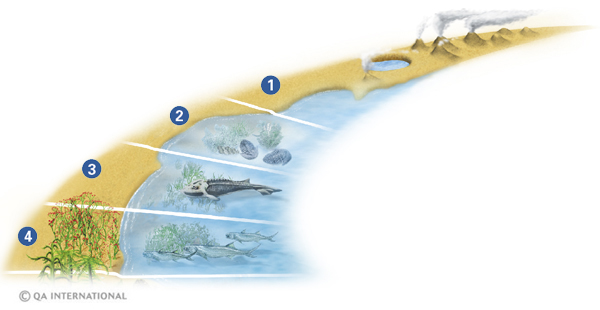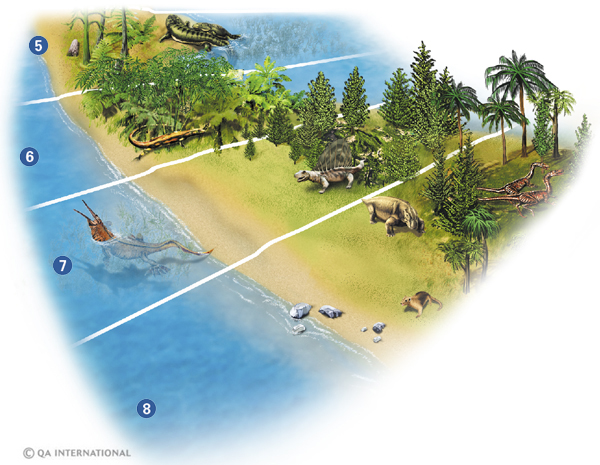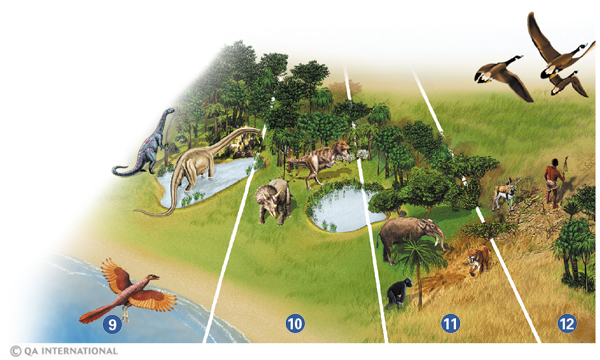
The origin of life on Earth: our collective history!
Life has existed on Earth for billions of years. The first organisms, which were microscopic, appeared in the ocean. They resembled the bacteria that we know today. The first algae and the first animals developed and gradually took over the seas. Once oxygen appeared in the atmosphere, life forms multiplied and became more complex and diversified. Certain plants and animals transformed over time, moving out of the water and going on to colonize the continents.
The major stages of the evolution of life
Scientists have divided the history of the Earth into major periods marked by the appearance or disappearance of animals and plants. Over time, very different living things have appeared, one after the other. For example, the development of a spinal column allowed certain animals to swim more efficiently, more than 400 million years ago. These first vertebrates were the fish. Little by little, certain fish developed lungs and feet and conquered dry land. They were the first amphibians, capable of surviving on land as well as in water. When the climate dried up about 300 million years ago, reptiles gained the upper hand over the amphibians, as they were better adapted to the arid environment. Even today, living things continue to disappear or evolve according to transformations in their environment.

- Precambrian (4 ,600–543 million years ago)
- Cambrian (543–488 million years ago)
- Ordovician (488–444 million years ago)
- Silurian (444–416 million years ago)
- Devonian (416–359 million years ago)
- Carboniferous (359–299 million years ago)
- Permian (299–251 million years ago)
- Triassic (251–200 million years ago)
- Jurassic (200–146 million years ago)
- Cretaceous (146–66 million years ago)
- Paleogenic (66–23 million years ago)
- Neogenic (23 million years ago to today)
About 3.5 billion years ago, the first microscopic organisms appeared in the ocean.
The first invertebrates developed in the oceans. They were soft-bodied animals with a shell or carapace, such as these trilobites.
Fish, like the agnathans, appeared. They were the first vertebrates, which are animals that have a spinal column.
The fish evolved and multiplied. Certain algae gradually adapted to living on dry land. They were the first terrestrial plants.

The first amphibians, such as the ichthyostega, moved out of the water. Insects also appeared on the continents, which were covered in giant ferns.
Reptiles make their appearance in immense swamps and coniferous forests. Certain insects, such as the dragonfly, develop wings.
The climate became drier and the reptiles multiplied, to the detriment of the amphibians. The first aquatic reptiles, such as the mesosaur, swam in the shallow waters.
Dinosaurs make their appearance. Mammals also appear, but most of them are no larger than mice.

Dinosaurs dominated the world. Certain reptiles transformed into birds. The first flowering plants appeared.
The flowering plants diversified. At the end of this period, three-quarters of the species disappeared, including the dinosaurs, probably after the fall of an enormous meteorite.
The small mammals benefited from the disappearance of the dinosaurs. They grew larger and diversified. The first great apes appeared.
The mammals and birds became major groups, and the first humans appeared.
Also see:
In the Visual Dictionary:
- "Animal Kingdom" section
- "Vegetable Kingdom" section
In the encyclopedic capsules :
- Species classification
- The food chain of living things
- Configuration of the continents
- The primates
- Marsupials
- Islands, treasure chests of biodiversity
- The fauna and flora of polar regions: Antarctic
- The deserts of the Americas and Africa
In the ikonet games:
- Put it in its place!:




